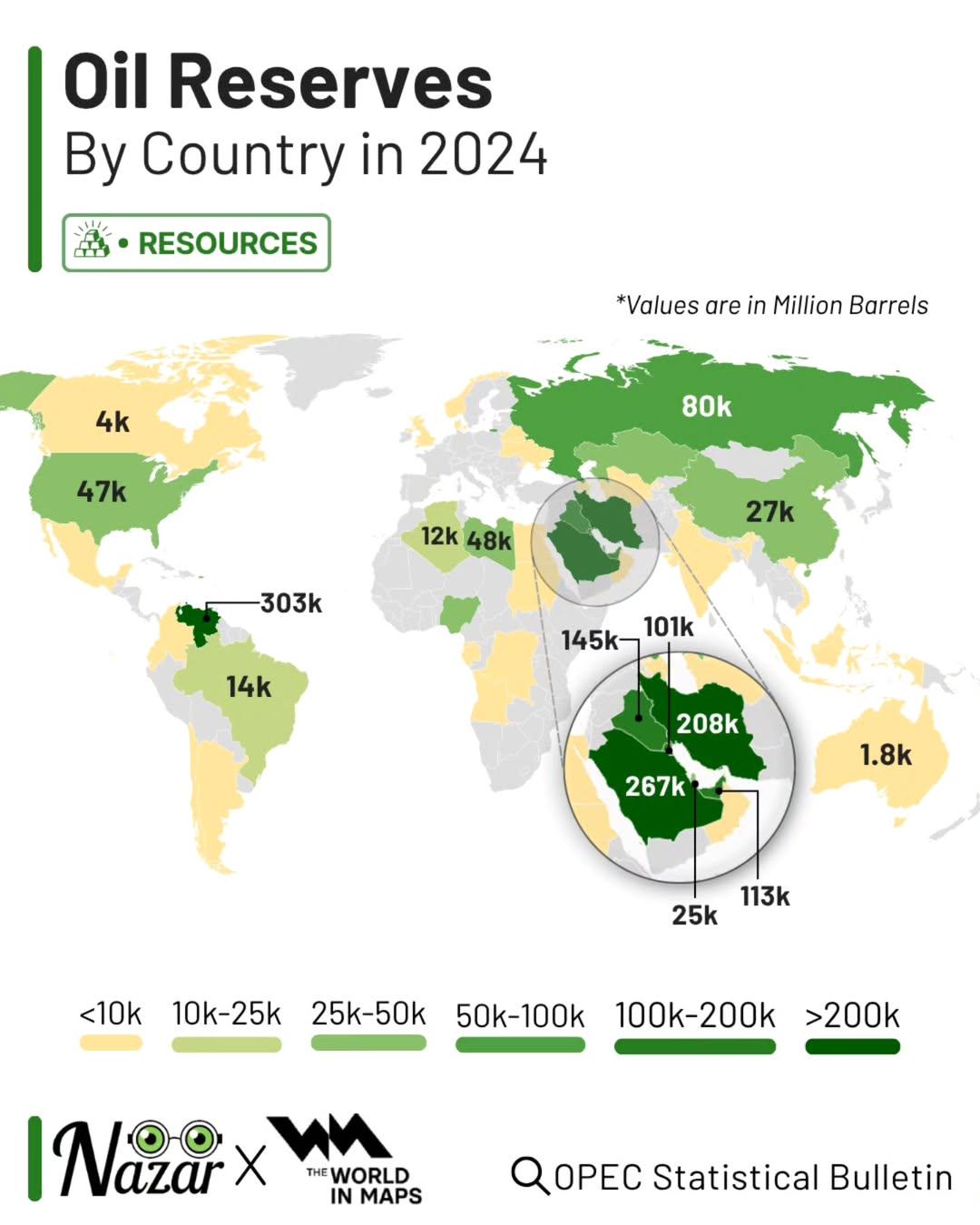Oil Reserves by Country Map 2024


David Chen
Data Visualization Specialist
David Chen is an expert in transforming complex geographic datasets into compelling visual narratives. He combines his background in computer science ...
Geographic Analysis
What This Map Shows
The "Oil Reserves by Country Map 2024" provides a clear visual representation of the world's oil reserves, highlighting the distribution and concentration of petroleum resources across different nations. This map showcases the estimated reserves in billions of barrels, offering insight into which countries hold the most significant oil wealth. As we delve deeper into the topic of oil reserves, it becomes essential to understand the factors influencing these reserves and their global implications.
Deep Dive into Oil Reserves
Oil reserves represent the amount of crude oil that can be extracted economically with current technology. According to the latest estimates, the world holds about 1.5 trillion barrels of proven oil reserves. These reserves are categorized into different classifications—proven, probable, and possible—each indicating the likelihood of extraction. The distinction between these categories is crucial for energy policy and economic planning.
Interestingly, the distribution of oil reserves is not uniform; a handful of countries dominate the global supply. The United States, Saudi Arabia, and Venezuela are among the top three holders. For instance, as of 2024, Venezuela holds approximately 303 billion barrels, making it the country with the largest proven reserves. However, the ability to extract and refine this oil varies greatly from one nation to another.
The extraction of oil is influenced by several factors, including technological advancement, political stability, and economic conditions. Countries with advanced drilling technologies, like the United States, can access tight oil reserves previously deemed too difficult to extract. This has led to a significant increase in domestic production, shifting the dynamics of the global oil market. In contrast, nations with political unrest may find their reserves underutilized. For example, Venezuela's political and economic crisis has drastically reduced its oil production despite its vast reserves.
What's fascinating is how oil reserves are not just an economic asset but also a geopolitical tool. Countries with large reserves often wield significant influence in global affairs, particularly in energy-dependent nations. The Organization of the Petroleum Exporting Countries (OPEC), a coalition of oil-producing countries, plays a crucial role in regulating oil supply and prices. OPEC's decisions can have ripple effects worldwide, impacting everything from fuel prices to international relations.
Regional Analysis
Examining the map by region reveals stark contrasts in oil reserves. The Middle East is the powerhouse of global oil, with Saudi Arabia leading the pack. With approximately 266 billion barrels, it continues to be a central figure in energy markets. Interestingly, the region's geopolitical tensions often arise from the competition for these valuable resources.
In contrast, North America has seen a boom in oil production thanks to technological innovations like hydraulic fracturing. The United States, now one of the top producers globally, boasts about 48 billion barrels in proven reserves. Meanwhile, Canada, with significant oil sands reserves, continues to expand its production capabilities, contributing to North America's growing influence in the global oil landscape.
Africa, while rich in natural resources, presents a mixed picture. Countries like Nigeria and Angola hold substantial reserves, yet face challenges such as corruption, infrastructure deficits, and political instability, which hinder their production capacities. In comparison, the oil-rich nations of the Middle East enjoy greater political stability and investment in extraction technologies, allowing them to maximize their reserve potential.
Significance and Impact
Understanding oil reserves is crucial not only for energy security but also for economic stability and international relations. As the world increasingly shifts towards renewable energy sources, the future of oil reserves raises important questions. How will the transition to greener energy impact countries dependent on oil revenues? Moreover, with climate change becoming a pressing global issue, the oil industry faces growing scrutiny regarding its environmental impact.
Furthermore, trends such as the rise of electric vehicles and increased energy efficiency are likely to influence future demand for oil. Countries with large reserves must adapt to a changing energy landscape to remain competitive. For instance, Saudi Arabia is investing in diversification strategies to reduce its dependency on oil revenue, showcasing a proactive approach to the looming challenges.
In conclusion, the "Oil Reserves by Country Map 2024" is not just a reflection of where oil is found but a window into the complex interplay of economics, politics, and environmental considerations shaping the future of energy. As we move forward, the implications of oil reserves will continue to resonate across the globe, influencing everything from local economies to international diplomacy.
Visualization Details
- Published
- October 24, 2025
- Views
- 6
Comments
Loading comments...